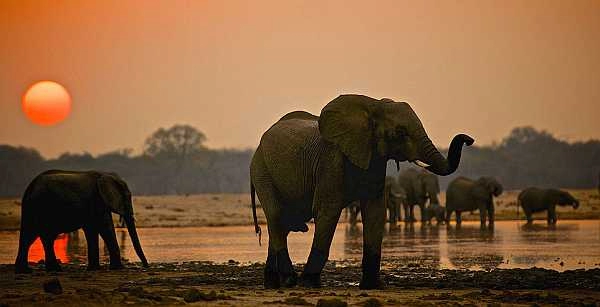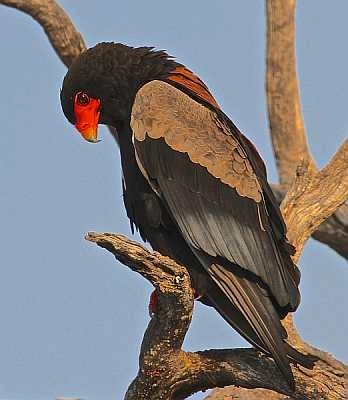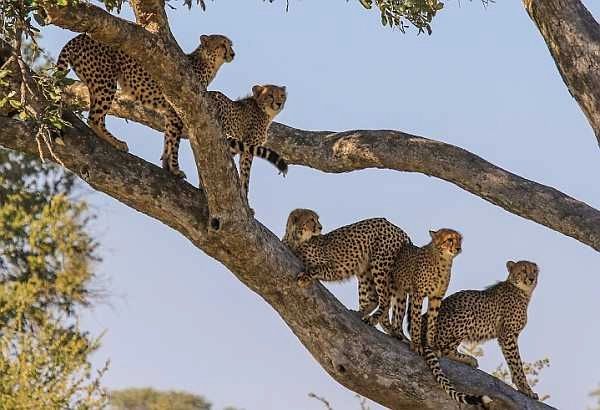Hwange National Park, formerly Wankie National Park is Zimbabwe's largest national park; both in size and in the variety of animals that can be seen here.

Hwange National Park, formerly Wankie National Park is one of Zimbabwe's largest parks both in size and in the variety of animals that can be seen here.
Once a royal hunting ground of the Zulu warrior King Mzilikazi, the park was proclaimed in 1929. Hwange boasts a tremendous selection of wildlife with over 100 species of mammals, 400 species of birds, 100 specis of trees and shrubs.
Once a royal hunting ground of the Zulu warrior King Mzilikazi, the park was proclaimed in 1929. Hwange boasts a tremendous selection of wildlife with over 100 species of mammals, 400 species of birds, 100 specis of trees and shrubs.
 Hwange National Park is just over 14 600 square kilometres and has a large elephant population of approximately 40 000 which all need to drink water twice a day. Hwange Park has little natural water and most of the water is pumped through boreholes into the pans and troughs. In fact, all the wildlife in the park have to rely on these series of waterholes, some of which dry up completely during drought years. This creates an excellent game viewing environment as wildlife congregates at these points.
Hwange National Park is just over 14 600 square kilometres and has a large elephant population of approximately 40 000 which all need to drink water twice a day. Hwange Park has little natural water and most of the water is pumped through boreholes into the pans and troughs. In fact, all the wildlife in the park have to rely on these series of waterholes, some of which dry up completely during drought years. This creates an excellent game viewing environment as wildlife congregates at these points.Hwange has amongst the highest diversity of mammals of any National Park in the world with over 108 mammal species and over 400 types of birds including 50 raptors.
There can be few experiences on this earth so gratifying as to sit at one of Hwange's viewing platforms by a waterhole, watching an endless procession of "Gods gifts" engaged in the timeless dance of survival.
The park is situated between Bulawayo and the world famous Victoria Falls. Hwange park is about a 2 hour drive from Victoria Falls. There is a good road infrastructure so self-drive is possible.
A 482km network of game viewing roads leads the visitor to some large concentrations of game and not too many other tourists.
Hwange offers diverse landscapes - dense teak forest in the north gives on to Kalahari sandveld in the south. In between, open grassy plains lined with acacia lie alongside mopane woodland and islands of ilala palms.
The seasons, too, impose dramatic changes on the park. During the hot summer rains between December and March the bush becomes lush and the wildlife disperses. Between June and October, the winter months see the bush rapidly dry and thin out, all but a few waterholes remain, and the wildlife is concentrated and easy to spot.
Hwange offers diverse landscapes - dense teak forest in the north gives on to Kalahari sandveld in the south. In between, open grassy plains lined with acacia lie alongside mopane woodland and islands of ilala palms.
The seasons, too, impose dramatic changes on the park. During the hot summer rains between December and March the bush becomes lush and the wildlife disperses. Between June and October, the winter months see the bush rapidly dry and thin out, all but a few waterholes remain, and the wildlife is concentrated and easy to spot.
People often ask us what the difference is between a safari in Hwange and other well known National Parks in Africa like Kruger National Park or Serengeti National Park for example and it is quite easy to answer this - VOLUME! Hwange has approximately 43 000 visitors a year compared to Serengeti which has approximately 350 000 a year (and is a very similar size as Hwange - 14,760km²) and Kruger which has 1.4 million visitors a year (Kruger's size is 19,480 km²)! In Hwange, it is likely you will spend most of your safari without seeing any other vehicles except those from the lodge where you are staying, making it a very exclusive experience!


Book your This email address is being protected from spambots. You need JavaScript enabled to view it. now.
